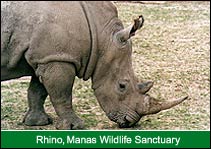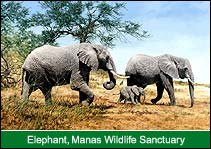 |
 |
 |
||
|
||||
Wildlife
Parks & Sanctuary In India
 Manas
Tiger Reserve in Assam was created in 1973 when Project Tiuger was launched
in India. The Reserve area falls in six districts. Kokrajhar, Bangaigaon, Barpeta,
Nalbari, Kamrup and Darrang of the Indian state of the Reserve. Manas is located
at the confluence of Indian, Ethiopean and Indo-Chineser realms resulting in
a magnificent bio-diversity.
Manas
Tiger Reserve in Assam was created in 1973 when Project Tiuger was launched
in India. The Reserve area falls in six districts. Kokrajhar, Bangaigaon, Barpeta,
Nalbari, Kamrup and Darrang of the Indian state of the Reserve. Manas is located
at the confluence of Indian, Ethiopean and Indo-Chineser realms resulting in
a magnificent bio-diversity.
It is situated on the northern bak of the river Brahmaputra. Their are numerous rivers criss-crossing the Reserve, namely Sankosh, Saralbangha, Hel, Tanali, Courang, Sidli (Bhor), Aio, Mans, Beki Pathimari, kaladia, Tihunala, Morepagaldia, Nala, Braalia, Pbornodi and Dhansiri.
The Reserve runs along the Indo-Bhutan international border, with contiguous wildlife habitats in Bhutan. The river Manas flows from the gorges of Bhutan and splits into tow major streams as it enters India,. The peace and tranquility of the site , Mahanguri is a gift of nature in its finest from.
 While
the core-zone, the Manas National Park, is a pristine wildlife habitat, the
rest of the Reserve is a collection of eighteen Reserve forest intertwined with
revenue villages. While traversing the Reserve from West to East one comes across
sal forest, both virgin and degraded, moist-decidous forest, isalated patches
of evergreen forest, riverine forest, grassland of both savannath and terai
types, and miscellaneous forests.
While
the core-zone, the Manas National Park, is a pristine wildlife habitat, the
rest of the Reserve is a collection of eighteen Reserve forest intertwined with
revenue villages. While traversing the Reserve from West to East one comes across
sal forest, both virgin and degraded, moist-decidous forest, isalated patches
of evergreen forest, riverine forest, grassland of both savannath and terai
types, and miscellaneous forests.
Manas habitat provides an excellent abode to the tiger as well as to its prey species: Hog deer, Sambar, Swamp deer, Asiatic wild buffalo and Indian Bison. These species migrate freely across the international border.
Forest Types
Core Zone
Sub-Himalayan High Alluvial Semi-Evergreen Forest
Easern Valoor Type of Forest
East Himalyan Moist Mixed Deciduous Forest
Low Alluvial Semi-Evergreen Alluvial Grassland
General Information :
Best Time to Visit : November to April
Nearest Town : Barpeta Road (40 Km)
How to Get Here :
Air : Guwahati (186 Km)
Rail : Barpeta Road (40 Km)
--------------------------------------------------------------------------------------------------------------------------------------------------------------------------------------------------
Manas Wildlife Sancturay
Manas Sight Seen¤ Tours with Manas ¤ Manas Wildlife Resorts
Manas Wildlife Conservation ¤ Manas Tigers ¤ Flora of Manas ¤ Fauna of Manas
Mammals Checklist of Manas ¤ Trees Checklist of Manas ¤ Manas National Park Fact File
Map of Manas ¤ Photo Gallery of Manas
-------------------------------------------------------------------------------------------------------------------------------------------------------------------------------------------------
Manas
Wildlife Sanctuary Manas Wildlife Sancturay
Manas Sight Seen¤ Tours with Manas ¤ Manas Wildlife Resorts
Manas Wildlife Conservation ¤ Manas Tigers ¤ Flora of Manas ¤ Fauna of Manas
Mammals Checklist of Manas ¤ Trees Checklist of Manas ¤ Manas National Park Fact File
Map of Manas ¤ Photo Gallery of Manas
-------------------------------------------------------------------------------------------------------------------------------------------------------------------------------------------------
 Manas
Tiger Reserve in Assam was created in 1973 when Project Tiuger was launched
in India. The Reserve area falls in six districts. Kokrajhar, Bangaigaon, Barpeta,
Nalbari, Kamrup and Darrang of the Indian state of the Reserve. Manas is located
at the confluence of Indian, Ethiopean and Indo-Chineser realms resulting in
a magnificent bio-diversity.
Manas
Tiger Reserve in Assam was created in 1973 when Project Tiuger was launched
in India. The Reserve area falls in six districts. Kokrajhar, Bangaigaon, Barpeta,
Nalbari, Kamrup and Darrang of the Indian state of the Reserve. Manas is located
at the confluence of Indian, Ethiopean and Indo-Chineser realms resulting in
a magnificent bio-diversity.It is situated on the northern bak of the river Brahmaputra. Their are numerous rivers criss-crossing the Reserve, namely Sankosh, Saralbangha, Hel, Tanali, Courang, Sidli (Bhor), Aio, Mans, Beki Pathimari, kaladia, Tihunala, Morepagaldia, Nala, Braalia, Pbornodi and Dhansiri.
The Reserve runs along the Indo-Bhutan international border, with contiguous wildlife habitats in Bhutan. The river Manas flows from the gorges of Bhutan and splits into tow major streams as it enters India,. The peace and tranquility of the site , Mahanguri is a gift of nature in its finest from.
 While
the core-zone, the Manas National Park, is a pristine wildlife habitat, the
rest of the Reserve is a collection of eighteen Reserve forest intertwined with
revenue villages. While traversing the Reserve from West to East one comes across
sal forest, both virgin and degraded, moist-decidous forest, isalated patches
of evergreen forest, riverine forest, grassland of both savannath and terai
types, and miscellaneous forests.
While
the core-zone, the Manas National Park, is a pristine wildlife habitat, the
rest of the Reserve is a collection of eighteen Reserve forest intertwined with
revenue villages. While traversing the Reserve from West to East one comes across
sal forest, both virgin and degraded, moist-decidous forest, isalated patches
of evergreen forest, riverine forest, grassland of both savannath and terai
types, and miscellaneous forests. Manas habitat provides an excellent abode to the tiger as well as to its prey species: Hog deer, Sambar, Swamp deer, Asiatic wild buffalo and Indian Bison. These species migrate freely across the international border.
Forest Types
Core Zone
Sub-Himalayan High Alluvial Semi-Evergreen Forest
Easern Valoor Type of Forest
East Himalyan Moist Mixed Deciduous Forest
Low Alluvial Semi-Evergreen Alluvial Grassland
General Information :
Best Time to Visit : November to April
Nearest Town : Barpeta Road (40 Km)
How to Get Here :
Air : Guwahati (186 Km)
Rail : Barpeta Road (40 Km)
Click
here for more information on Manas
Click here for Suggested Tours with Manas
Click here for Suggested Resorts / Jungle Camps / Lodges in Manas
Click here for Suggested Tours with Manas
Click here for Suggested Resorts / Jungle Camps / Lodges in Manas
Click here for Reservation / More Information
Wildlife
Parks & Sanctuary In India
Bandhavgarh National Park Bharatpur Bird Sanctuary
Bharatpur Bird Sanctuary  Corbett National Park
Corbett National Park
Ranthambore National Park Kanha National Park
Kanha National Park  Manas Wildlife Sanctuary
Manas Wildlife Sanctuary
Panna National Park Periyar Wildlife Sanctuary
Periyar Wildlife Sanctuary  Gir National Park
Gir National Park
Sunderbans National Park more...
more...
Bandhavgarh National Park
Ranthambore National Park
Panna National Park
Sunderbans National Park
| Home | About Us | FAQ's | Contact Us | Commendations | Reservation |
| Copyright © Wildlife India Plus ( All Rights Reserved. ) | Web Development & SEO Services by |

